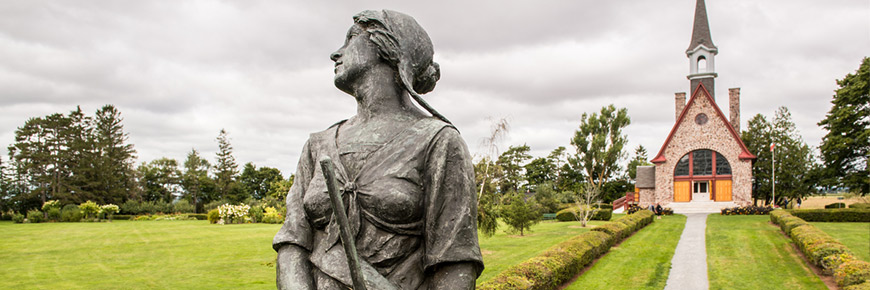
Conservation treatment of the Evangeline statue
Grand-Pré National Historic Site
Outdoor bronze sculptures, such as Evangeline at Grand Pre, are exposed to the elements 365 days a year; their surfaces get covered in pollen, dirt and bird droppings and become home to numerous insects and spiders. Every two years Parks Canada conservators step in to clean these valuable objects and protect them for years to come.
Below is an overview of the steps needed to protect the statue of Evangeline at Grand Pré National Historic Site.
Assessing the statue's condition
Step one is to examine the surface of the statue and make a report on its condition. This includes looking for any areas that may have become weakened or cracked. If these areas exist, great care will be taken to avoid more damage during treatment, and if need be repairs to the sculpture are undertaken.
Cleaning the statue
Step two is to remove dirt, pollen, insects / pests, and bird droppings. These are unsightly and their acid by-products can lead to corrosion of the bronze surface. Being near the sea, the Evangeline statue is also exposed to salty air, and so salt deposits need to be removed as well. Finally, any old coatings from previous treatments are removed to so that the new protective coat will create a uniform barrier. This cleaning is done using a simple soap and water solution.
Loose debris and dirt are removed from the surface using a pressure washer. Next the conservator will use a solution of mild soap and water and a stiff, non-metallic bristle brush to scrub off any areas where the dirt is tenaciously adhering to the surface. After a final rinse of the statue with water, the surface is ready for waxing.
Applying Wax
Step three of the process involves heating the surface and applying a custom blend of hard waxes. Regular paste wax would be too soft for an outdoor sculpture and would break down too quickly.
The surface is heated using a propane torch, and when a sufficient temperature is reached the wax is applied using a brush. The heated wax flows across all areas of the statue and soaks into its semi porous surface. Any excess wax is removed while it is still hot.
Buffing
Step four involves letting the statue cool and then buffing the waxed surface with a lint free cloth.
The wax coating will keep future dirt and debris and the salt air from having direct contact with the metal and will reduce the amount of corrosion that would otherwise form naturally. It also brings the patina to a uniform appearance and a more saturated look.
By the time two years has passed, the wax succumbs to the elements and the statue of Evangeline will need to be treated again.
Related links
- Date modified :